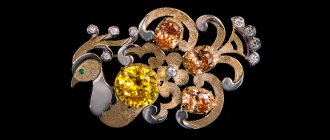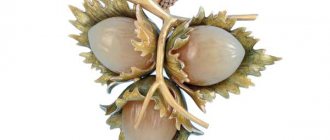Who it
The main task of a jeweler is to make jewelry.
Often, craftsmen also provide jewelry repair services, adjusting the sizes of rings, bracelets or chains. In jewelry factories or workshops, division of labor is accepted. Jewelers here are considered not only designers, but also foundry workers, loaders, assemblers who are responsible for the technical part of the work.
The specialist is helped in his work by many tools - jigsaws, files, soldering irons, magnifying glasses. Sometimes, when performing complex original works, completely new devices and mechanisms of original production are used.
In his craft, a jeweler uses precious and non-ferrous metals, precious and semi-precious stones. When creating an artistic product, common techniques include forging, casting, artistic embossing, carving or engraving.
Skills and requirements for the profession of a jeweler
Anyone who wants to master the profession of a jeweler must know what skills and abilities this specialist must have, who will be involved in the process of making real works of art. Key skills include the following:
- knowledge of the specifics of working with each of the precious materials, knowledge in the industry of not only precious, but also semi-precious minerals and their physical properties;
- the ability to take a creative approach to work and have a well-developed creative taste;
- knowledge of the rules by which the process of drawing up drawings, sketches, engraving and various ornaments takes place;
- maximum accuracy, since when creating jewelry, one wrong move can lead to the formation of defects or even damage to the future jewelry. It doesn’t matter whether you work with a mineral such as amber, or with precious stones;
- such personal characteristics as scrupulousness and perseverance, a tendency to perform constant work with hands, concentration and ideal vision.
With all these skills and abilities, we can be sure that we are dealing with a good jeweler.
What does it include
Before you learn to be a jeweler and become a real master, it’s worth understanding what such a professional actually does. Learn the basics of the profession and understand what skills are needed to get started.
A jeweler is a professional who works with precious metals and stones. There are narrowly focused craftsmen who work only with cutting, finishing or casting. As well as general specialists who can turn a piece of raw gold and gemstone into a real work of art.
Thanks to the development of technology, you can learn the skill of creating 3D models of jewelry, on the basis of which automation will produce a suitable product. And also master artistic painting on precious metals using enamel and turn into an artist.
Regardless of your specialization, to become a jeweler, you need to start by studying the properties of metal alloys, precious stones and basic working techniques. And also understand whether painstaking and careful work is suitable for you or whether computer graphics is closer.
Statistics data. A craftsman who works manually with precious metals earns on average from 35 to 70 thousand rubles per month. Designers who can create a piece of jewelry from scratch are paid a piece rate for each piece.
Tasks and Responsibilities
The specialist's responsibilities will depend on his qualifications. Thus, an engraver engraves jewelry made of precious metals, and an assembler mounts parts of the product, connecting it into a single whole.
Regardless of his main functions, a jeweler must be able to describe the precious metals, stones and other materials used, as well as the various methods of processing them. The master must be able to read the drawings of the products being created and know GOST standards.
Work and salary
Beginners in the jewelry business begin their professional journey in factories or factories, where they can grow to a 7th grade jeweler. The most experienced and talented specialists open their workshops and participate in international exhibitions.
Jewelers have enough opportunities to advance their careers, but even at the initial stage, the salary of such a specialist will be high - from 50,000 rubles, depending on the place of work.
Pros and cons of the profession
Working as a jeweler has its advantages and disadvantages. The advantages of this profession include:
- demand for work;
- high salary;
- opportunity for career growth.
The disadvantages are often highlighted:
- painstaking, intense nature of the work;
- the need to stay in one position for a long time, which can lead to diseases of the spine and back.
How to become a jeweler: where and how long do you need to study jewelry making?
Reading time: 5 minutes(s) Since ancient times, people have processed natural materials and made jewelry from them. Over time, the process of creating accessories improved, and with the invention of special mechanisms, jewelry began to resemble real works of art.
Today, the profession of a jeweler is considered quite in demand, since the production of jewelry is a complex and delicate work.
Who is a jeweler: what do you need to know about the profession?
The main task of a jeweler is to make jewelry. Often, craftsmen also provide jewelry repair services, adjusting the sizes of rings, bracelets or chains.
In jewelry factories or workshops, division of labor is accepted. Jewelers here are considered not only designers, but also foundry workers, loaders, assemblers who are responsible for the technical part of the work.
The specialist is helped in his work by many tools - jigsaws, files, soldering irons, magnifying glasses. Sometimes, when performing complex original works, completely new devices and mechanisms of original production are used.
In his craft, a jeweler uses precious and non-ferrous metals, precious and semi-precious stones. When creating an artistic product, common techniques include forging, casting, artistic embossing, carving or engraving.
Tasks and Responsibilities
The specialist's responsibilities will depend on his qualifications. Thus, an engraver engraves jewelry made of precious metals, and an assembler mounts parts of the product, connecting it into a single whole.
Regardless of his main functions, a jeweler must be able to describe the precious metals, stones and other materials used, as well as the various methods of processing them. The master must be able to read the drawings of the products being created and know GOST standards.
Work and salary
Beginners in the jewelry business begin their professional journey in factories or factories, where they can grow to a 7th grade jeweler. The most experienced and talented specialists open their workshops and participate in international exhibitions.
Jewelers have enough opportunities to advance their careers, but even at the initial stage, the salary of such a specialist will be high - from 50,000 rubles, depending on the place of work.
Pros and cons of the profession
Working as a jeweler has its advantages and disadvantages. The advantages of this profession include:
- demand for work;
- high salary;
- opportunity for career growth.
The disadvantages are often highlighted:
- painstaking, intense nature of the work;
- the need to stay in one position for a long time, which can lead to diseases of the spine and back.
How to learn to be a jeweler?
There are several ways to master the profession of a jeweler. Some graduates enter a secondary school or higher education institution in order to obtain a solid knowledge base that will allow them to expand their future field of activity. Others choose to study with a practicing master or study on their own. Often, if a newcomer to this field has basic knowledge and skills, as well as initial experience, it is possible to work as a jeweler without specialized education.
What skills are needed?
Representatives of this profession know the rules of working with materials, types of precious stones, and their physical properties. They also know the basics of sketching, drawing, decorating and engraving.
For this specialty, it is mandatory to have a developed artistic taste and a creative approach to work. A jeweler must have perseverance, attentiveness, be scrupulous, and also have a penchant for working with his hands and excellent eyesight.
What education is needed and where can I go?
Jewelry making is a fairly popular specialty in higher education institutions. In order to become a master, you should choose the direction “Jewelry Making”, “Decorative and Applied Arts”.
Those who wish to master this craft can study at a secondary specialized educational institution or university.
What subjects need to be taken?
To enter a higher education institution or secondary school, you will need to pass a unified state exam in the form of testing. Most often, graduates demonstrate their knowledge of the Russian language, history, and mathematics. The educational institution may also require you to take part in a creative drawing or drawing competition.
How long does it take to study to become a jeweler after grades 9 and 11?
Studying at a higher educational institution in specialty programs takes 5 years, after which the graduate can already work in specialized companies. After 9th grade, an applicant will master a craft in colleges or technical schools for 2-3 years, depending on the training program of a particular secondary school.
Jeweler is a creative profession, which requires the presence of certain knowledge and skills, as well as creativity in the master. That is why true professionals never stop there, continuing to hone their knowledge in advanced training courses, seminars and trainings.
Is distance learning possible?
Many commercial educational institutions offer distance learning in jewelry making. Such training programs are designed for accomplished specialists who want to improve their level of knowledge and undergo retraining.
Where can I get training in jewelry making?
Many educational institutions in Russia provide the opportunity to master the profession of a jeweler.
Universities and academies
You can study to become a jeweler at higher educational institutions in Moscow.
- Moscow branch of the Higher School of Folk Arts. Offers training in the specialty “Jewelry Art”. The training program is conducted on the basis of a bachelor's degree (4 years), training is free.
- Moscow State Academy of Arts and Industry named after Stroganov. It trains specialists for 4 years on a budget basis, and there are also contract places. Price – from 167,000 rubles.
- National Research Technological University. Prepares bachelors in the field of “Technology of Artistic Processing of Materials”. Training is conducted on a budget basis.
- Moscow State University of Design and Technology. It involves obtaining a bachelor's degree, there are budget places, and a contract form of education.
- Moscow State University. The Faculty of Geology trains specialists in geology. Qualifications can be obtained at different levels of higher education. Budget places are available.
Some universities in St. Petersburg also offer a similar specialty.
- Peter the Great St. Petersburg Polytechnic University. It trains general specialists, and there are budget places available. Contract price – from 68,000.
- St. Petersburg Technological Institute. State university, recruits students for full-time training, there are budget places.
- St. Petersburg Mining University. Offers several training programs, contract price from 260,000 rubles.
- St. Petersburg State Marine Technical University. Graduates specialists in the field of “Technology of artistic processing of materials”. Training is conducted on a budget basis; paid training is also possible - from 62,000 rubles.
- Institute of Decorative and Applied Arts. Non-state educational institution, budget places are not provided. The duration of training is 4 years, the cost of the contract is from 150,000 rubles.
- St. Petersburg State University of Technology and Design. Conducts training for jewelry specialists within the Institute of Applied Arts. Full-time training, duration – 5 years. There are budget places.
Colleges and technical schools
Graduates of 9th grade can receive basic training at Moscow colleges and technical schools.
- Art and Industrial College named after Vasnetsov. Trains artists of decorative and applied arts. Training is conducted on a budget basis.
- College of Decorative and Applied Arts No. 36 named after Carl Faberge. The duration of training based on the 9th grade will be 3 years 5 months, the cost of the contract is from 68,000 rubles.
- Moscow educational complex. Offers to obtain the specialty “Jeweler”, duration of training is from 34 months, contract price from 120,000 rubles.
- College of Gzhel State University. It trains specialists for 46 months, there are 50 budget places. The contract price is from 92,000 rubles.
- College of Entrepreneurship No. 11. Specialists are trained on the basis of 9th and 11th grades, there are budget places.
It is possible to complete secondary specialized education after 9th grade in the direction of “Jeweler” in St. Petersburg.
- St. Petersburg Artistic and Professional Lyceum named after Carl Faberge. It is considered one of the best artistic educational institutions. Trains jewelers on the basis of 9th and 11th grades. Training is provided at the expense of budget funds.
- College of Service and Industrial Technologies. Graduates specialists with a training base of 34 months. There are no contract places; training is provided at the expense of budget funds.
- Restoration College "Kirovsky". Conducts training of specialists in the profile “Artistic and design works performer”. There are 25 budget places, the duration of training is 34 months.
- Leningrad Regional College of Culture and Art. Recruits applicants in the field of “Decorative and Applied Arts”, duration of study is 46 months.
- Restoration and Art College. Conducts training in several training programs. There is a budget, the contract price is from 74,000 rubles.
Jewelers courses
Moscow offers a wide range of courses for jewelers.
- Short-term courses at the Moscow State Academy of Arts and Industry. The university offers additional courses and continuing education programs. The duration of classes and the cost of training are calculated individually.
- Courses and master classes from the Vasnetsov Art and Industrial College. The educational institution provides additional education lasting 72 hours. Upon completion of classes, a certificate is issued.
- "Russian Academy of Crafts". A non-state educational institution provides short-term training and advanced training courses for students with secondary and higher education. Duration – from 72 hours, cost from 3,000 rubles.
- "Workshop of Free Jewelers." Conducts jewelry courses and master classes. The institution is ready to provide employment for talented graduates. The duration of the courses is from 109 hours, the cost is 27,000 rubles.
- "Glass Academy" Conducts courses, master classes and exhibitions. Classes can be held individually or in a group, the duration of classes is 72 hours.
There are similar programs in St. Petersburg.
- School of Jewelry Art. Offers commercial courses in the specialty "Jeweller" and additional education. The duration of the course is 10 months, the price of training is from 10,500 per month.
- Higher School of Folk Arts. There are courses in artistic metal processing. Duration – from 4 hours, cost from 5,000 rubles.
- Educational. Conducts enrollment of students for courses lasting 1 month. Price – 25,500 rubles.
- Jewelry school on line 19. Provides training in several areas. Duration of classes - 6 months, cost - from 12,500 rubles.
- Jewelry school "Karat". The course “Fundamentals of Jewelry Craftsmanship” is conducted on schedule, 3 times a week, the cost of one academic month is 13,500 rubles.
Thus, the profession of a jeweler is creative, creative and interesting. These specialists can work in private workshops, factories, and jewelry stores. They also make good appraisers and employees of expert bureaus.
Did this article help you? We would be grateful for your rating:
17 3
Peculiarities
A detailed description of the profession of a jeweler should begin with the fact that this is one of the most ancient crafts. Moreover, initially the master’s work was largely associated with the production of objects for religious and sacred purposes (at that time these included jewelry). Over time, many aspects have been transformed, but some things have remained virtually unchanged - for example, the personal qualities inherent in a jeweler. First of all, this is a combination of creativity and readiness for painstaking, routine work, as well as perseverance, a good eye, accuracy, and the presence of artistic abilities.
Interesting facts about the jeweler’s profession should be supplemented by the amount of knowledge that a good craftsman possesses. He makes sketches, composes compositions, works with metals, stones and other materials, and each area requires its own specific theoretical training and practical skills. Thus, a jeweler must know the laws of composition and compatibility of materials, be able to draw on paper and make 3D models on a computer. And of course, his responsibilities include working with metals, stones and much more.
Part 1 - getting started with jewelry
1 Buy a jewelry kit to make your own jewelry
Jewelry making kits provide you with the basic materials and tools to make your own. Most kits come with some basic instructions with different jewelry ideas, but you can use your imagination to create any kind of jewelry you want. Depending on what kind of jewelry you want to make, there are many options for jewelry kits. For example , there are beading jewelry sets, beading jewelry sets and wire jewelry sets.
2 Select a specific jewelry project you want to try
Because there is a huge variety of possible jewelry (necklaces, bracelets, earrings), made from a variety of possible materials (beads, wire, thread, resin, paper, etc.), choose the material and gemstones to create the jewelry with your own the hands you would like to work with. Find inspiration by visiting jewelry stores or look online on social platforms, visual organization websites, or jewelry store websites.
3 Materials for making jewelry
Depending on what kind of decorations you plan to make, you will likely need some basic tools to complete your project. [ Some basic tools for beginners to consider:
- Various pliers - round nose pliers, chain nose pliers, chain nose pliers, curved pliers and nylon pliers
- Metal ruler that measures both centimeters and inches
- Wire cutters
- Wire or wire to create the base of jewelry
- Peg boards for wire bending
4 Buying handmade jewelry
Handmade jewelry can be made from many different types of supplies, but there are a few basic supplies that are used for most handmade jewelry. Jewelry making kits can provide you with general or project materials, but if you plan to start making jewelry without using a kit, you will need to purchase some materials on your own.
Need to buy :
- Beads
- Jewelry wire in general sizes (18, 20 and 22); 20 is better for beginners
- Studs for earrings
- Locks and closures
- Jump rings
5 Familiarize yourself with basic jewelry measurements
To determine how big or small you want your jewelry piece to be, check out some basic jewelry measurements. There are common standard sizes for necklaces and bracelets (depending on whether the jewelry is for men or women) and what specific sizes you want to achieve. For example, different styles of necklaces have a certain length.
Chokers are about 38 cm long, princess style necklaces are about 45 cm long, and rope necklaces are about 86 cm long or more. Necklaces that fall just below the collar bone tend to measure around 17 inches for women and around 50 cm for men.
The total length of the bracelets is about 18 cm for women and 25 cm for men.
6 Learn basic jewelry making skills and techniques
To begin the process of making your own jewelry, you must learn some basic skills and techniques to successfully complete your project. Common skills and techniques to learn include making jump rings, cutting wire, wiring, slicing and using jigs and pegs, etc. To learn these different techniques, you can read jewelry books, look for tutorials, and conduct jewelry making workshops. Search the Internet for instructions on how to make the specific earrings, bracelet, ring or other types of jewelry you want to try.
7 Gather the necessary materials
Once you have the jewelry project you want to make selected, gather all the necessary materials. Again, your materials can come from a jewelry making kit, or you can research the style of jewelry, determine the level of difficulty, and then purchase the materials needed yourself. For example, to start creating charm earrings, you first need to choose the materials you want to use. The project you want to create can be found on the Internet, in craft stores or jewelry stores. Then you need to select your earring results, which are the parts of the earring. When you are ready to start making your jewelry, proceed to the instructions you purchased on how to make the jewelry item.
8 Practice technique before doing work with expensive materials
As mentioned earlier, for wire jewelry, practice wire is a good idea to practice and perfect your jewelry making skills before moving on to bending and cutting more expensive wire. This way, you can hone your skill with more repetitions, so your final product will be better. No matter what kind of jewelry material you use, always try to practice this technique first before using your real precious jewelry materials. Thin copper wire is always a good choice for practical applications.
Who is it suitable for?
The profession is one of the most in demand: jewelry salons constantly advertise vacancies, workshops for making and repairing jewelry are open in all cities. It’s not difficult to get a job, and what’s important for this is not so much a document about graduating from an educational institution, but rather a skill. Most craftsmen do not have higher education, and sometimes even any diploma or certificate. Salary depends on qualifications, region and place of work. On average, a beginning master earns 15-25,000 rubles per month. Experienced and famous jewelers can earn from 30,000 to 100,000. Higher earnings are available only in Moscow.
Main directions
To study to become a jeweler, you need to choose a field of activity. It is impossible to master everything at once in any profession. The main specializations of the masters include:
- creating models of future products, preparing sketches and transferring them to a 3D version;
- casting, processing and mounting of metal precious parts of future works of jewelry;
- applying ornaments, patterns, fonts, engravings and other decorative elements;
- processing of precious stones and their fixation in products;
- creating designs using jewelry enamel, applying a special protective layer, spraying and working with colored clay.
First jewelry experience
In this article I want to present the information that I myself searched for a very long time on the Internet when I became a jeweler. Suppose you decide to engage in this most interesting creative activity. Where to start? I remember the moment when I firmly decided to master this craft, saved some money, about 30 thousand rubles, and went to a jewelry tools store.
When I was in it, I stood for a very long time and looked at these huge display cases with various incomprehensible things and could not even ask the seller for anything, since I had no idea what I needed to do at least the easiest work, like pouring a simple ring without stones.
I stood there for a long time until the man who was the owner of the store came out to me, and seeing that I was slowing down and annoying the seller, he began to ask me about my desires. After a short conversation, I decided what I needed and bought it. I left the store with two bags of the necessary tools to make a simple ring with one large stone in the center, you can see it in the photo above, with a blue stone.
What do they do
The easiest option is to make pure craft
and create jewelry based on other people’s sketches, do repairs and adjustments.
If you add artistic vision to craft skills, seriously study applied and fine arts, design and 3D modeling, you can become a jewelry designer
and accessories. Often such people are required in large jewelry companies, especially many vacancies abroad.
An ordinary designer can eventually become a director of a department
or responsible for the product line.
Another option is to engage in expertise
and professionally evaluate finished products or stones.
The most talented and ambitious accessory designers create their own jewelry brands
.
What skills will be required?
There are many courses on the global network “How to become a jeweler” that offer training in the basics of craftsmanship. But before signing up for free and paid trainings, professionals recommend reading Erhard Brepohl’s book “Theory and Practice of Jewelry Making.” And also analyze your character and understand whether it has the following traits:
- perseverance, because manual work is very painstaking;
- curiosity - all jewelers are constantly improving their skills;
- analytical mind to study all the properties of alloys;
- creative spirit to create unique sketches;
- patience, because not everything works out the first time;
- the ability to sell your skills to get a job in the future or receive direct orders as a self-employed citizen.
Skills in working with a blowtorch, jigsaw and nail file will also come in handy if you want to work with the metal itself. Ability to work in 3D modeling programs when you decide to become a jewelry designer. As well as the ability to carefully and smoothly process stones when choosing to work with gems.
Where to begin
If you are asking this question and want to become a real professional in your field, then it makes sense to think about entering a secondary specialized or higher educational institution in the relevant specialty. In our country, this can be done both free and for a fee.
If you just want to be able to make jewelry for yourself and your loved ones, jewelry making courses are best for you. Here you will be taught the basics of the profession. Thus, you can feel like a real master even without special education.
Where to study
In Russia, jewelry making is taught mainly at geological faculties or at creative universities in the specialty “Artistic processing of metals.” Students study gemology, try to process stones and metals, and learn to evaluate the origin and cost of materials. The emphasis in Russian education is on craft skills.
If you dream of not only fulfilling other people's orders, but also creating your own design, it is better to go to Europe. Already during your studies, you will be able to collaborate with leading fashion houses and at the end will receive a portfolio with your own line of jewelry.
Where to study in Moscow?
Anyone who wants to become a jeweler, regardless of their training, is invited to the J-design.pro school of jewelry design. Both full-time and correspondence courses are organized here, which are designed in such a way that students step by step master all the skills of a professional jeweler and, upon completion of the program, can create their own products . Training lasts from six months (for entry-level) to two years (for professional level).
When forming the program, significant attention was paid not only to technical, but also to artistic aspects. Future masters are taught to think, analyze and evaluate, and are instilled with artistic taste. That is why students of full-time courses go with teachers to specialized exhibitions, where they get acquainted with products made by professionals and analyze them.
Higher education institutions
The profession of “jeweler,” which is briefly described above, implies the presence of a complex of knowledge and skills. You can purchase them at the specialized university. The basics of jewelry making are also taught in college. Finally, you can take specialized courses that last only a few weeks.
Those who take a thorough approach to mastering the profession should choose one of the universities below:
- Moscow branch of VSHNI.
- Art and Industry Academy named after. Stroganov.
- Moscow State University of Design and Technology.
- Moscow Research Technological University.
There are not many universities that provide education in the jeweler profession. But there are many higher educational institutions that have a design department. After graduation, you can continue your training in the jewelry profile.
Universities
- Ural Federal University named after the first President of Russia B.N. Yeltsin Technology of artistic processing of materials (Institute of New Materials and Technologies of UrFU)
- Russian State University named after A.N. Kosygina (Technology. Design. Art)
- Technology of artistic processing of materials (Institute of Mechatronics and Information Technologies of the A.N. Kosygin Russian State University (Technology. Design. Art))
- Novosibirsk State Technical University Technology of artistic processing of metal materials (Faculty of Mechanics and Technology of NSTU)
- Russian State Geological Prospecting University named after Sergo Ordzhonikidze Technology of processing of precious stones and metals (Institute of Geology of Mineral Resources MGRI-RGGRU)
- Russian Chemical-Technological University named after D.I. Mendeleev Technology of artistic processing of materials (Faculty of technology of inorganic substances and high-temperature materials of the D.I. Mendeleev Russian Chemical Technical University)
Where can I study to become a jeweler in Moscow?
Everyone who wants to become a jeweler, regardless of their training, is invited to the J-design.pro school of jewelry design. Both full-time and correspondence courses are organized here, which are designed in such a way that students step by step master all the skills of a professional jeweler and, upon completion of the program, can create their own products . Training lasts from six months (for entry-level) to two years (for professional level).
When forming the program, significant attention was paid not only to technical, but also to artistic aspects. Future masters are taught to think, analyze and evaluate, and are instilled with artistic taste. That is why students of full-time courses go with teachers to specialized exhibitions, where they get acquainted with products made by professionals and analyze them. The J-design.pro school provides students with everything they need to become a jeweler, start producing their own products and subsequently, possibly, open their own brand of exclusive jewelry.
Colleges and technical schools
Graduates of 9th grade can receive basic training at Moscow colleges and technical schools.
- Art and Industrial College named after Vasnetsov. Trains artists of decorative and applied arts. Training is conducted on a budget basis.
- College of Decorative and Applied Arts No. 36 named after Carl Faberge. The duration of training based on the 9th grade will be 3 years 5 months, the cost of the contract is from 68,000 rubles.
- Moscow educational complex. Offers to obtain the specialty “Jeweler”, duration of training is from 34 months, contract price from 120,000 rubles.
- College of Gzhel State University. It trains specialists for 46 months, there are 50 budget places. The contract price is from 92,000 rubles.
- College of Entrepreneurship No. 11. Specialists are trained on the basis of 9th and 11th grades, there are budget places.
Jewelry schools: colleges and secondary vocational education
First of all, specialized colleges and schools are of interest - arts and arts and crafts. Most of them are departments of universities from the first group:
MOSCOW: Moscow branch of the Higher School of Folk Arts (formerly the Institute of Traditional Applied Arts) - college (secondary vocational education) - see above in the universities section.
MOSCOW (MOSCOW REGION): Art and Industrial College named after Vasnetsov, Abramtsevo branch of the Moscow Academy named after. S.G. Stroganov. Prepares artists of decorative and applied arts (wood carving, stone carving, metal carving, bone carving, design, etc.) Duration of training: 3g 10m Address: Khotkovo village, Moscow region Website: ahpkv.ru
MOSCOW: College of Decorative and Applied Arts No. 36 named after Carl Faberge The college was created in 2005, and offers training in the specialty “Jeweler”, as well as “Incrustation” and “Design in the jewelry industry”. College graduates who are professional jewelers become heads of production sites, leading designers, artists and technologists, and owners of their own businesses. College graduates with the profession of “Jeweler” can continue their studies at the college with a specialty in “Design in the Jewelry Industry”, as well as in higher educational institutions. Duration of training: 3 years 5 years - based on 9 classes, or 1 year 10 years based on 11 classes Address: Moscow , st. Shipilovskaya, 17/1, building 2 Website: collegefaberge.mskobr.ru
MOSCOW: The first Moscow educational complex was created in 2014 on the basis of four Moscow colleges: Technological College No. 14, College of Arts and Crafts No. 59, College of Entrepreneurship No. 15, Moscow Art and Pedagogical College of Technology and Design. The complex offers the specialty “Jeweler” (as well as, for example, the specialty of decorative and applied arts). Address: Moscow, Tikhomirov str. 10 k.1 Website: artcollege.ru
KOSTROMA: Krasnoselskoye School of Artistic Metalworking (KUKHOM) is a branch of the Moscow Academy named after. S.G. Stroganov. Provides training for specialists in full-time secondary vocational education programs. At KUKHOM they train to be: - designer for the jewelry industry (training period 3 years 10 years) - artist of folk arts and crafts (training period 2 years 10 years) Address: Kostroma region; village Krasnoe-on-Volga Website: https://www.kyxom.ru
In addition to specialized courses, jewelry making can also be studied in colleges with a more universal focus. The profession of a jeweler in such schools is presented along with numerous other specialties useful for the “national economy”. There are similar secondary vocational educational institutions in many cities. Let's give examples of several Moscow schools:
MOSCOW: College of Entrepreneurship No. 11 Among other specialties, they train there to become a “Diamond cutter into brilliants.” Graduates can perform all diamond cutting work using modern equipment and technological equipment. There are budget and commercial options. Website: kp11.mskobr.ru
MOSCOW: Polytechnic College No. 13 named after P.A. Ovchinnikov The technical school, among other specialties, declares “Jeweler - basic training.” According to the information on the website, training is free, enrollment without exams. Graduates receive a state diploma of secondary vocational education with secondary general education. Duration of training: 3g 5m (based on 9 classes) or 1g 10m based on 11 classes. Address: Moscow city, Bibirevskaya street, 6, bldg. 1 Website: spo-13.mskobr.ru
SAINT PETERSBURG: SGBPEU “Artistic and Professional Lyceum of St. Petersburg named after Carl Faberge” - where they will teach the specialty “jewelry” on the basis of 9 or 11 grades. Address: St. Petersburg, Energetikov Ave., 4, building 2 (Ladozhskaya metro station) Website: hpl11.ru
EKATERINBURG: The Ural technical school "Rifey" will help you master the craft of a jeweler. Training based on grades 9 or 11, qualification - jeweler, cutter. Website: ut-rifey.ru/obrazovanie/80-54-01-02-yuvelir
ROSTOV-ON-DON: DPTK PU 8, multifunctional center for applied qualifications - courses for jewelers (vocational training program), 5 months, introduction to the profession. Address: https://pu8vertol.ru/index/kontakty/0-5 Website: https://pu8vertol.ru/index/prof_obrazovaniye/0-51
NIZHNY NOVGOROD: Pavlovsk College of Folk Art Crafts of Russia, there are specialties of jeweler, designer and others Address: Nizhny Novgorod region, Pavlovo, Mayakovsky, 28 Website: https://www.arts-college.ru/
How to choose a course
Dozens of choices of schools and studios are overwhelming. To choose effective jewelry courses , we recommend looking at the following points:
- Goals: do you want to repair products, work from someone else’s sketches, or create your own.
- How many years has the school been operating?
- Availability of a license to carry out educational activities.
- Find out about the teachers: experience, skills, products.
- Works of graduates.
- Reviews on forums and social networks. Pay attention to how the school reacts to outside opinions: they explain whether cases are examined. Or they ignore complaints.
- View more prices to get the average price. Compare the cost of approximately the same number of classes and program content. Sometimes the high price is justified by a well-known brand, teachers, or expensive rent in a posh center.
- The school may be named after a well-known person in the community. Be careful: often this is only a name. It is not necessary that the master conducts the classes. Especially for beginners.
- Find out if the school offers open or trial lessons. During such visits, you can evaluate the school’s equipment and teaching methods.
- For job opportunities, look for courses that will lead to a certificate or rank.
- A big plus is the possibility of employment.
Pay attention to the important points for you: how comfortable it is in the workshop, work schedule, common language with the teacher. Studying is productive when it is fun.
Career prospects
During their studies, all Istituto Marangoni students collaborate with fashion houses in Italy, which gives them the opportunity to gain experience and make professional contacts. In addition, much attention is paid to management skills and market research - the university trains not just artisans, but proactive creators who are ready to put their ideas to work.
Based on the results of the training, the institute organizes public screenings and meetings with key industry players. For many, graduation is already the beginning of a successful career.
Interesting Facts
Jewelry craftsmanship has a rich history, during which many interesting events took place:
- A necklace made of mollusk shells is considered the oldest piece of jewelry : according to experts, the age of the product is at least 115 thousand years.
- The founder of the Cartier brand is the first master who used platinum to create jewelry. Previously, coins were mainly made from metal.
- Working with precious materials requires calmness and scrupulousness from craftsmen, therefore, before entering educational institutions, applicants are required to undergo examination by a narcologist and psychologist.
- The profession of a jeweler is considered hereditary , which is passed on from generation to generation - usually the fate of a child in such families is already predetermined from childhood.
- The most valuable jewelry is considered to be those found on the ocean floor after the Titanic disaster. The collection includes: necklaces, pins, brooches, rings and, of course, the most important thing – the “Heart of the Ocean” necklace, which can be seen on the heroine of James Cameron’s film.
- Due to its plasticity, gold quickly loses its shape, so it is never used in its pure form, but is alloyed with other metals.
- The dark blue Wittelsbach diamond is the most expensive in the world - its cost is approximately $80 million.
Jewelry craftsmanship is a real art. Despite the high work requirements and existing disadvantages, this profession remains one of the most in demand, creative and highly paid in the world.
DO YOU WANT TO DIVE INTO THE PRICELESS AND PRECIOUS WORLD OF JEWELRY ART?
This Training Video Course Reveals What You Always Wanted to Know - How to Master the Profession of a Jeweler!
Why am I so sure that I can give you a magic key that will open the door to the world of jewelry - captivating wealth and seductive beauty?
Jewelry is a girl's best friend at all times. Beautiful colors, bright rich tones, dazzling shine, grace and beauty - it is difficult for female representatives to resist such temptation. It is impossible to imagine the world of women without jewelry!
Jewelry is a product that does not succumb to the spell of time and fashion, and does not know what old age is.
Handmade jewelry is always highly valued and looks more prestigious.
JEWELRY MAKING IS NOT ONLY A NOBLE BUT ALSO A PROFITABLE OCCUPATION!
ALL THE MOST POWERFUL SECRETS, HINTS, TOOLS AND TECHNIQUES EVER WRITTEN (OR DISCUSSED) ARE INCLUDED IN THIS VIDEO TRAINING COURSE!
That is why thousands of people every day attend expensive jewelry making schools, sign up for numerous courses, master all sorts of techniques, follow the recommendations of their friends, study tons of literature, hoping to learn the secrets of this art.
BUT YOU CAN CHOOSE ANOTHER PATH, SHORTER AND EFFECTIVE - order the author’s training video course “TIPS FOR A BEGINNING JEWELER”
By completing the course, you will be able to save money, not limit yourself to time limits, learn basic jewelry making skills, and engage in a profitable business.










